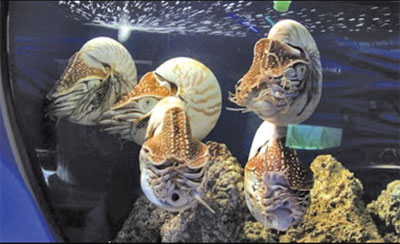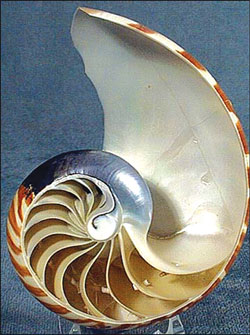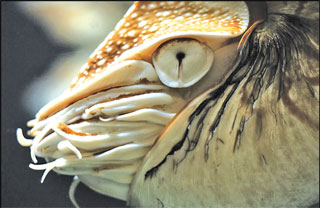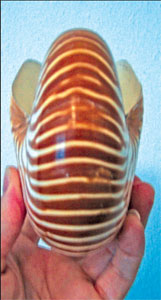Nautilus, the living fossil from the deep sea
The word ‘nautical’ is sure to conjure images of the sea and sailors
in your mind. So, when you hear the world ‘nautilus’, you would know
that it’s related to the ocean. Sure enough, ‘nautilus’ means ‘sailor’
in Greek and refers to a squid-like creature which has a beautiful shell
and lives in the sea. It was referred to as ‘sailor’
|

Nautilus pompi |
by the ancients who believed that this creature used two expanded
arms as sails.
The nautilus is a mollusc and a member of the cephalopod family known
as Nautilidae. It is closely related to other cephalopods such as the
squid, cuttlefish and octopus. There are several species of nautiluses
(or nautili as their plural form is also known) of which the the largest
and most common is the chambered nautilus (Nautilus pompilius) which is
also known as the emperor nautilus due to its size.
The nautilus lives among coral reefs, in the tropical waters of the
Pacific and Indian Oceans, from the Andaman Sea east to Fiji and from
southern Japan to the Great Barrier Reef. It lives at dark, cold depths
of 900 to 2,000 feet during the day and rises to shallower waters, 300
to 500 feet, at night to feed. It generally avoids water temperatures
above 25 degrees Celsius.
This mysterious creature, which spends most of its time in deep
water, uses the method of jet propulsion to move through water at speeds
of over two knots. A small tube near its tentacles, known as a siphon,
expels water under pressure. This propels the nautilus in the opposite
direction at high speeds.
|
 | |
A tank of chambered nautiluses at the California
Academy of Sciences Natural History Museum |
The nautilus has a smooth white shell which is adorned with chocolate
brown zebra stripes. This strong shell protects its soft body. As it
grows, it keeps expanding its shell, adding internal chambers in a
perfect logarithmic spiral. Its body is in the last chamber and includes
tentacles and a large eye. The tentacles, which look different in
appearance to the tentacles of squid, function mainly in smelling and
manipulating food. When threatened by predators, the nautilus withdraws
its entire body into this armoured shell and seals the door with a
tough, leathery hood which is formed of two especially folded tentacles.
The shell is coiled and pressure resistant, imploding at a depth of
about 800 metres (2,600 ft). It is composed of two layers: a matte white
outer layer, and a striking white iridescent inner layer. The innermost
portion of the shell is blue-gray.
|

Inner construction of the nautilus shell which
shows the gas compartments it uses to rise or sink. |
The shell colouration provides the animal with a means of camouflage
known as counter-shading. When seen from above, the shell is darker in
colour and marked with irregular stripes, which helps it blend into the
dark water below. The underside is almost completely white, helping it
hide in the brighter waters near the surface.
The shell comprises many individual chambers. Each chamber is
individually sealed and contains gas. This provides the nautilus with
buoyancy (the ability to float in a liquid or rise in a fluid). It can
regulate its density by injecting or removing fluid into its chambers
through a system of tubes.
The nautilus is similar in form to other cephalopods, with a
prominent head and tentacles. However, it has more tentacles than other
members of the family. Depending on the species, there can be up to 90
separate tentacles which are arranged in two circles. Unlike other
cephalopods, they have no suction cups. The tentacles are used to catch
prey, which are then crushed with the nautilus’ powerful beak. They are
active predators, but need to eat only about once a month.
|

Inner construction of the nautilus shell which
shows the gas compartments it uses to rise or sink. |
Their eyesight is poor because their eyes have no lenses. Instead,
there is a tiny hole to allow light into the eye in a system which
operates like a pinhole camera. The nautilus relies mainly on its sense
of smell when searching for food or looking for a mate.
Unlike the large, complex brains of octopuses and squid, nautili have
a simpler brain and had long been assumed to lack intelligence. However,
recent experiments have shown that this is not so, and that they have
good memory power as well as the ability to respond to events.
The nautilus has an unusually long life span for a cephalopod, about
20 years, and take many years to reach maturity. Nautiluses reproduce
annually. The female fertilises about a dozen eggs and deposits them,
one at a time or in small groups, throughout the year. The eggs measure
more than an inch in length, making them among the largest of
invertebrate eggs. They have a long incubation period, ranging from nine
months to over a year. No one has ever seen nautilus eggs in the wild so
little is known about the environment in which they are laid. It is
believed that their eggs resemble cloves of garlic. They are usually
attached to rocks in shallow water, and hidden from predators.
Nautiluses rarely breed successfully in captivity.

A nautilus shell viewed from above and from underneath |
 |
A young nautilus is about an inch in diameter and has a shell with
seven chambers. It will drift and feed on plankton and other small prey
as it grows, adding new chambers to its shell.
A variety of Nautilus pompilius from north-western Australia, once
called Nautilus repertus, may reach 26.8 centimetres in diameter, but
most nautilus species never exceed 20 centimetres. Nautilus macromphalus
is the smallest species, usually measuring around 16 centimetres. A
dwarf population from the Sulu Sea (Nautilus pompilius suluensis) is
even smaller, with a diameter of 11.5 mm.
Its diet mainly consists of hermit crabs, fish, and the exoskeletons
(outer skeletons) of moulting (shedding skin, feathers, hair etc.)
crustaceans. They locate food by rising up the water at night and using
their tentacles to smell the ocean currents for traces of dead or dying
prey. They in turn become prey to octopuses, sharks, triggerfish and
turtles who can penetrate their shell. Nautiluses are described as
‘living fossils’ because they have remained virtually unchanged for
millions of years (See box for examples of living fossils). They are
believed to have appeared on Earth about 500 million years ago, during
the Cambrian Explosion, 265 million years before dinosaurs walked the
Earth. Then, there had been about 10,000 different species of nautilus,
but only about six species are known to survive today.
They too are facing the threat of extinction as their beautiful shell
has made them an attractive commodity commercially. Despite the export
of nautili being illegal in many countries, they are caught using baited
traps and the shells are sold. That, coupled with their slow rate of
reproduction and limited ecological range have raised concerns among
conservationists. Scientists are now studying their populations to
determine whether they need protection under the United Nations
Convention on International Trade in Endangered Species.
- IT
[Scientific classification]
• Kingdom: Animalia
• Phylum: Mollusca
• Class: Cephalopoda
• Subclass: Nautiloidea
• Order: Nautilida
• Superfamily: Nautilaceae
• Family: Nautilidae
• Genus: Allonautilus (A. perforatus and A. scrobiculatus)
• Genus: Nautilus (N. belauensis, N. macromphalus, N. pompilius
[includes N.p. pompilius and N.p. suluensis] and N. stenomphalus (N.
belauensis and N. Stenomphalus are now assumed to be sub-species of N.
pompilius)
[Some other creatures which are known as living fossils]
• Mammals: Aardvark, Amami rabbit, Cypriot mouse, elephant shrew,
Laotian rock rat, Iriomote cat, monotremes (platypus and echidna),
okapi, Sumatran rhinoceros
• Birds: New Zealand wren, broad-billed sapayoa, bearded reedling,
mousebird, magpie goose, Andean condor and Californian condor, osprey,
razorbil
• Reptiles: Alligator snapping turtle, crocodile, pig-nosed turtle,
snapping turtle, tuatara
• Amphibians: Giant salamander, purple frog
• Fish: Hagfish, Northern brook lamprey, arowana and arapaima,
bowfin, coelacanth, gar, Queensland lungfish, sturgeon and paddlefish,
blind shark, elephant shark, goblin shark
• Insects: Gladiator, parasitic wood wasp, peloridiid bug, jurodid
beetle
• Crustaceans: Mantis shrimp, tadpole shrimp
• Molluscs: Nut clam, vampire squid
• Other invertebrates: Horseshoe crab, trapdoor spider |


